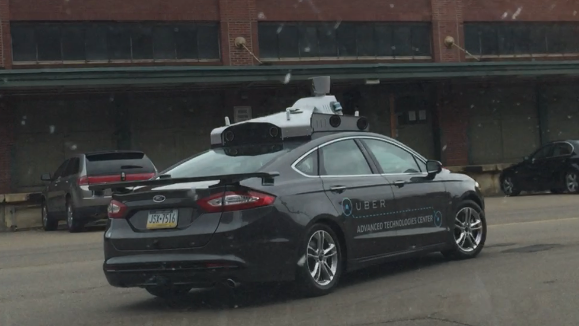See Correction/Clarification at the end of this article.
While Uber Technologies Inc. has been quietly setting up shop in Pittsburgh for its Advanced Technologies Center, the company's test cars that are now hitting the road are less inconspicuous.
If the words "Uber Advanced Technologies Center" emblazoned on the side of the vehicle weren't enough of a giveaway, the device rotating on the top of the vehicle signals this isn't your average Ford.
"This vehicle is part of our early research efforts regarding mapping, safety and autonomy systems," Uber spokeswoman Trina Smith said in an email. But it is not a self-driving car, the company said later after word leaked out.
It's likely you'll be seeing more on the road in Pittsburgh as the company builds out its local operations. Uber announced in February it would be opening an advanced technologies center in Pittsburgh to focus primarily on the areas of mapping, vehicle safety and driverless vehicle technology.
Smith declined to provide more details, and from a competitive standpoint, that isn't surprising. Uber is hardly the only company looking to take a stake in self-driving vehicle technology.
Uber's announcement it would be developing its own self-driving car technology put the company in direct competition with one of its biggest investors: Google (Nasdaq: GOOG).
Google has been working on driverless car technology since 2010 and has said it expects to have a finished product by 2020.
This summer, the company's self-driving cars are graduating from the test track and will hit the real road in Google's hometown of Mountain View, Calif. The car has no steering wheel or pedals, so it is up to the internal computers to do all of the driving. (However, to keep with California law these early treks will have a human aboard with a removable steering wheel and pedals, should something go wrong.)
For Uber, driverless cars eliminate its largest cost: the driver. By the end of 2014, the rideshare startup employed about 160,000 drivers across the globe.
In a report released Tuesday by Barclays Plc, analyst Brian Johnson said the shift to driverless vehicles is a big benefit to transportation network companies like Uber.
“By removing the driver from the equation (the largest cost in a taxi ride), the average cost per mile to the consumer could be 44 cents for a private ride in a standard sedan and 8 cents for a shared ride in a two-seater,” Johnson wrote. It would also drop the rate of taking an Uber “well below” the $3 to $3.50 a mile consumers now pay to ride in an UberX car or the $1 to $1.50 a mile for an UberPool vehicle, he said.
Uber CEO Travis Kalanick has been outspoken about his desire to replace the people who drive its cars with cars that drive themselves.
"The reason Uber could be expensive is because you're not just paying for the car — you're paying for the other dude in the car," Kalanick said. "When there's no other dude in the car, the cost of taking an Uber anywhere becomes cheaper than owning a vehicle."
Barclay's Johnson predicts that auto sales may drop 40 percent in the next 25 years because of shared driverless cars. The market for autonomous technology is expected to grow to $42 billion by 2025 and self-driving cars may account for a quarter of global auto sales by 2035, according to an analysis by Boston Consulting Group.
In order to hit the ground running, Uber hired away dozens of senior researchers from CMU's National Robotics Engineering Center prior to the announcement of a partnership between the two.
CMU has a well-established reputation in the area of autonomous driving. The university currently operates the General Motors-Carnegie Mellon Autonomous Driving Collaborative Research Lab, which was formed after CMU's driverless car won the DARPA Urban Challenge in 2007.
In February, Jeff Holden, Uber's chief product officer, said the company was staffing the center with a mix of CMU recruits and others brought in from outside the university. Uber has yet to disclose how many it currently employs at the center, but the company has been actively hiring for an array of engineering positions.
Earlier this week, Uber confirmed it has selected the former Restaurant Depot space in the Strip District as the location for its Advanced Technologies Center. Smith said the company expects to move in at the end of the year.
Correction/Clarification
Headline changed to reflect Uber saying it wasn't a self-driving car traveling in Pittsburgh.
